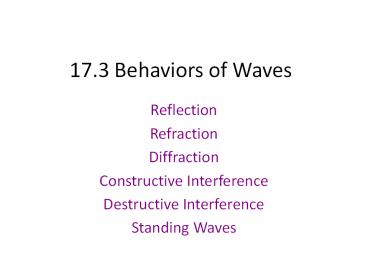17.3 Behaviors of Waves - PowerPoint PPT Presentation
Title:
17.3 Behaviors of Waves
Description:
17.3 Behaviors of Waves Reflection Refraction Diffraction Constructive Interference Destructive Interference Standing Waves Reflection When a wave bounces off a ... – PowerPoint PPT presentation
Number of Views:522
Avg rating:3.0/5.0
Title: 17.3 Behaviors of Waves
1
17.3 Behaviors of Waves
- Reflection
- Refraction
- Diffraction
- Constructive Interference
- Destructive Interference
- Standing Waves
2
Reflection
- When a wave bounces off a surface that it cannot
pass through - Ex. ball cant pass through a wall, so it
bounces off - Reflection does not change the speed or frequency
of a wave, but the wave can be flipped upside
down - Fixed boundary ? reflected wave upside down
3
Refraction
- The bending of a wave as it enters a new medium
at an angle - Occurs when a wave enters a medium at an angle
- One side of the wave moves more slowly than the
other side - Refraction applet
- In this case, v different refractive value for
a different medium
4
Diffraction
5
Diffraction PhET diffraction applet
- The bending of a wave as it moves around an
obstacle or passes through a narrow opening - A wave diffracts more if its wavelength is large
compared to the size of an opening or obstacle - If wavelength lt opening/obstacle, then very
little bending - If wavelength gt opening/obstacle, then larger
bending
6
Interference
- When 2 or more waves overlap and combine together
- 2 types of interference
- Constructive (leads to increased amplitude)
- Destructive (leads to decreased amplitude)
7
Constructive interference
- When 2 or more waves combine to produce a wave
with a larger displacement (amplitude)
8
Destructive Interference
- When 2 or more waves combine to produce a wave
with a smaller displacement (amplitude)
9
Standing Waves
- A wave that appears to stay in one place it
does not seem to move through the medium - Examples plucked guitar string or elastic cord
- Node a stationary point on a standing wave
- Complete destructive interference between
incoming and reflected waves - Antinode a point where a crest or trough occurs
midway between nodes - Forms only if a wavelength or a multiple of half
a wavelength fits exactly into the length of a
vibrating cord.
10
Standing Waves
- Links to Standing Waves Applets
- Standing wave created by reflecting off of 1
barrier - http//faraday.physics.utoronto.ca/IYearLab/Intros
/StandingWaves/Flash/reflect.html - Standing wave created by reflecting off 2
barriers - http//faraday.physics.utoronto.ca/IYearLab/Intros
/StandingWaves/Flash/standwave.html































